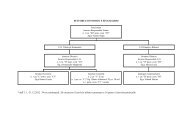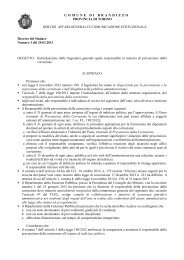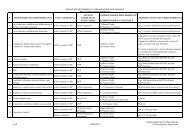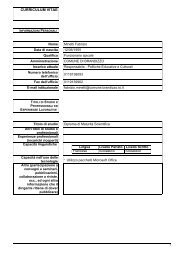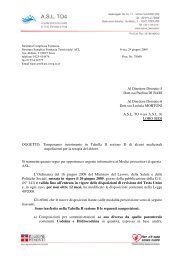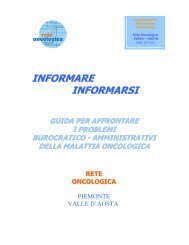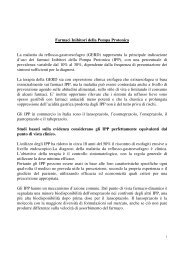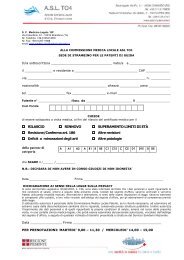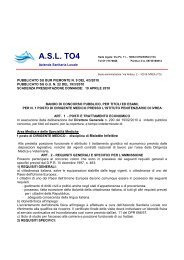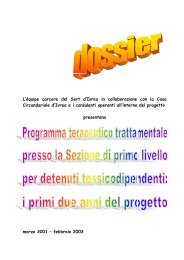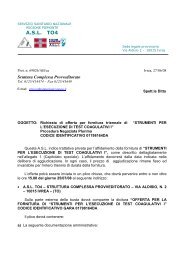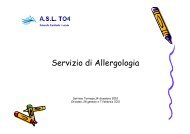Articolo sulla casistica delle non idoneità allo sport agonistico in ...
Articolo sulla casistica delle non idoneità allo sport agonistico in ...
Articolo sulla casistica delle non idoneità allo sport agonistico in ...
You also want an ePaper? Increase the reach of your titles
YUMPU automatically turns print PDFs into web optimized ePapers that Google loves.
BODY EQUILIBRIUM AND CONNECTIVE TISSUE GALLOZZI<br />
with the consequent dim<strong>in</strong>ution <strong>in</strong> the ability to<br />
move. As a f<strong>in</strong>al result we have an alteration <strong>in</strong><br />
the plasticity and lability of the connective tissue<br />
structure with the consequent formation of<br />
ribbons which make the tissue less elastic. In<br />
these areas we observe an <strong>in</strong>crease <strong>in</strong> fibroblasts<br />
and fibres <strong>in</strong> the direction of traction. These areas<br />
can be observed readily on the body surface.<br />
Usually they are found close to bone surfaces or<br />
<strong>in</strong> the crossover zones of the large muscular masses<br />
and they very sensitive and pa<strong>in</strong>ful.<br />
These adaptations are difficult for the patient<br />
or therapist who does the assessment, to detect. 6<br />
If we f<strong>in</strong>d changes <strong>in</strong> a particular body district<br />
it is, as we have said, possible that the orig<strong>in</strong>al<br />
lesion occurred elsewhere with an immediate,<br />
corrective response <strong>in</strong> all secondary areas, <strong>in</strong>clud<strong>in</strong>g<br />
the place where the symptoms appeared.<br />
The restrictions <strong>in</strong> a given region characterized by<br />
areas of hypertony and fixity may generate a<br />
reduction <strong>in</strong> the freedom of movement <strong>in</strong> other<br />
zones <strong>in</strong>clud<strong>in</strong>g the more distal ones. In other<br />
words, coord<strong>in</strong>ative capacity is altered, namely<br />
the sequence of actions that characterise the activity<br />
of the neuromotor system which determ<strong>in</strong>es<br />
and controls movement. The zone where the<br />
patient perceives pa<strong>in</strong> is, <strong>in</strong> fact, often a long<br />
way from the areas of relative fixity of the fascial<br />
system. 3, 6, 22, 24<br />
Pa<strong>in</strong> and posture<br />
The previous paragraph <strong>in</strong>troduced the relationship<br />
between pa<strong>in</strong> and modification of the<br />
myofascial system. Accord<strong>in</strong>g to the researcher<br />
Vladimir Janda 25-27 there is an <strong>in</strong>terdependence<br />
between the muscle-skeleton system and the<br />
Central Nervous System. In particular, muscular<br />
tone is put <strong>in</strong> relation to the presence of chronic<br />
“pa<strong>in</strong>”.<br />
Our musculature, postural and phasic, reacts to<br />
pa<strong>in</strong>. Postural musculature tends to <strong>in</strong>crease its<br />
tone and then shortens. Phasic musculature tends<br />
to dim<strong>in</strong>ish its tone and become weak. The consequence<br />
is that, <strong>in</strong> the presence of pa<strong>in</strong>, we<br />
have a modification <strong>in</strong> posture related to the muscular<br />
imbalances that are determ<strong>in</strong>ed.<br />
The most typical pictures regard the musculature<br />
of the trunk and the scapular belt with weakness<br />
<strong>in</strong> the cervical flexors, <strong>in</strong>crease <strong>in</strong> the tone<br />
of the pectorals and sternocleidomastoid, <strong>in</strong>crease<br />
<strong>in</strong> tension of the superior trapezius and scapular<br />
elevator and weakness <strong>in</strong> the <strong>in</strong>ferior trapezius<br />
and anterior serrate. The picture determ<strong>in</strong>es an<br />
Questi adattamenti tessutali sono difficili da rilevare<br />
dal paziente o dal terapeuta che ne effettua la<br />
valutazione 6.<br />
Se troviamo dei cambiamenti <strong>in</strong> un determ<strong>in</strong>ato<br />
distretto corporeo è, come detto, possibile che la<br />
lesione orig<strong>in</strong>aria sia accaduta altrove con una<br />
risposta immediata e correttrice <strong>in</strong> tutte le aree<br />
secondarie <strong>in</strong>cluso il luogo nel quale si manifestano<br />
i s<strong>in</strong>tomi. Le restrizioni <strong>in</strong> una regione determ<strong>in</strong>ata,<br />
caratterizzate da aree di ipertonia e fissità,<br />
possono orig<strong>in</strong>are una riduzione nell’ampiezza<br />
del movimento <strong>in</strong> altre zone, <strong>in</strong>cluse quelle più<br />
distali. In altri term<strong>in</strong>i, vengono ad alterarsi le capacità<br />
coord<strong>in</strong>ative, ossia la sequenza <strong>delle</strong> azioni<br />
che caratterizzano l’attività del sistema neuromotorio<br />
che determ<strong>in</strong>a e controlla il movimento. La<br />
zona dove il paziente percepisce il dolore è, <strong>in</strong>fatti,<br />
spesso molto distante dalle aree di relativa fissità<br />
del sistema fasciale 3, 6, 22, 24.<br />
Dolore e postura<br />
Nel paragrafo precedente è stato già <strong>in</strong>trodotto<br />
il rapporto esistente tra dolore ed alterazione del<br />
sistema miofasciale. Secondo il ricercatore Vladimir<br />
Janda 25-27 esiste una <strong>in</strong>terdipendenza tra il sistema<br />
muscolo-scheletrico ed il Sistema Nervoso Centrale.<br />
In particolare viene messo <strong>in</strong> relazione il tono muscolare<br />
con la presenza del “dolore” cronico.<br />
La nostra muscolatura, posturale e fasica, reagisce<br />
al dolore. La muscolatura posturale tende ad aumentare<br />
il suo tono, e qu<strong>in</strong>di si accorcia. La muscolatura<br />
fasica a dim<strong>in</strong>uire il tono ed a diventare debole.<br />
La conseguenza è che si ha, <strong>in</strong> presenza di dolore,<br />
una modificazione della postura legata agli squilibri<br />
muscolari che si vengono a determ<strong>in</strong>are.<br />
I quadri più tipici riguardano la muscolatura<br />
del tronco e del c<strong>in</strong>golo scapolare con debolezza<br />
dei muscoli flessori cervicali, aumento del tono dei<br />
pettorali e dello sternocleidomastoideo, aumento di<br />
tensione del trapezio superiore e dell’elevatore della<br />
scapola e debolezza del trapezio <strong>in</strong>feriore e del serrato<br />
anteriore. Il quadro determ<strong>in</strong>a aumento della<br />
cifosi dorsale, <strong>in</strong>trarotazione ed elevazione <strong>delle</strong><br />
scapole, sofferenza del tratto cervicale della colonna<br />
(Figure 10,11).<br />
Altro quadro caratteristico si riscontra a carico<br />
della muscolatura del bac<strong>in</strong>o e degli arti <strong>in</strong>feriori con<br />
aumento di tensione a livello del retto femorale e<br />
degli ileo-psoas, debolezza degli addom<strong>in</strong>ali, del<br />
gluteo medio e del grande gluteo ed aumento di<br />
tono degli erettori del tronco. Tale quadro agisce<br />
prevalentemente sul tratto lombare della colonna<br />
con aumento della lordosi e rigidità di tale distretto.<br />
Vol. 62, N. 4 MEDICINA DELLO SPORT 405



